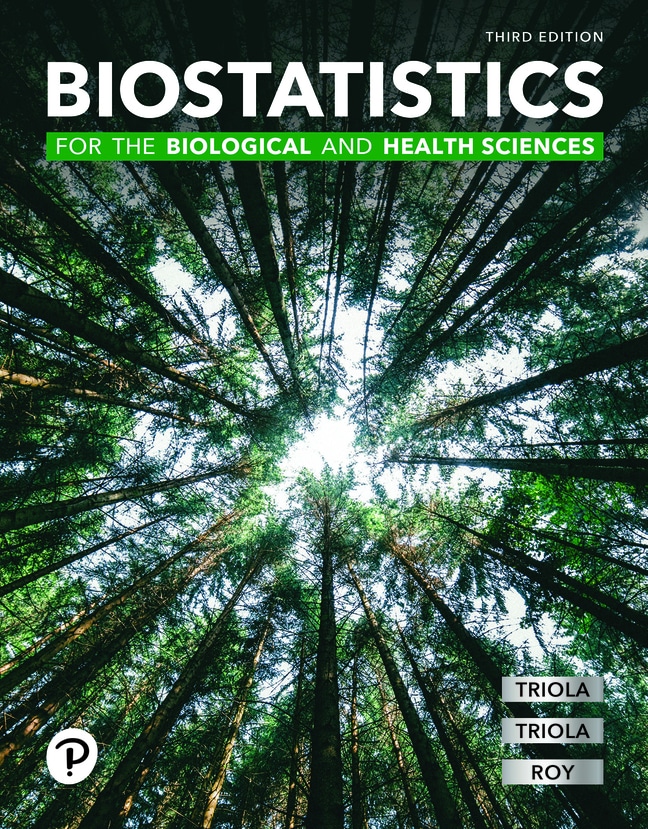
Biostatistics for the Biological and Health Sciences, 3rd edition
- Mario F. Triola
- , Marc M. Triola
- , Jason Roy

- Find it fast
Quickly navigate your eTextbook with search
- Stay organized
Access all your eTextbooks in one place
- Easily continue access
Keep learning with auto-renew
Biostatistics for the Biological and Health Sciences brings statistical theories and methods to life with real applications, a broad range of examples, emphasis on real data and a friendly writing style. It is designed to suit a wide variety of students in their first statistics course, uses minimal algebra and will help you develop skills in critical thinking, technology and communication. This collaboration from 2 biological sciences experts and the author of the #1 statistics book is an excellent introduction that is also highly readable, understandable, interesting and relevant.
The 3rd Edition incorporates the latest and best methods used by professional statisticians. It provides an abundance of new and interesting data sets, examples, and exercises (such as those involving clinical trials, COVID-19, biometrics, and anthropometrics); and it includes features that address all of the recommendations included in the Guidelines for Assessment and Instruction in Statistics Education (GAISE) as recommended by the American Statistical Association.
Published by Pearson (July 6th 2023) - Copyright © 2024
ISBN-13: 9780137863792
Subject: Advanced Statistics
Category: Biostatistics
1. Introduction to Statistics
- 1-1 Statistical and Critical Thinking
- 1-2 Types of Data
- 1-3 Collecting Sample Data
- 1-4 Ethics in Statistics (download only)
2. Exploring Data with Tables and Graphs
- 2-1 Frequency Distributions for Organizing and Summarizing Data
- 2-2 Histograms
- 2-3 Graphs That Enlighten and Graphs That Deceive
- 2-4 Scatterplots, Correlation, and Regression
3. Describing, Exploring, and Comparing Data
- 3-1 Measures of Center
- 3-2 Measures of Variation
- 3-3 Measures of Relative Standing and Boxplots
4. Probability
- 4-1 Basic Concepts of Probability
- 4-2 Addition Rule and Multiplication Rule
- 4-3 Complements, Conditional Probability, and Bayes' Theorem
- 4-4 Risks and Odds
- 4-5 Rates of Mortality, Fertility, and Morbidity
- 4-6 Counting
5. Discrete Probability Distributions
- 5-1 Probability Distributions
- 5-2 Binomial Probability Distributions
- 5-3 Poisson Probability Distributions
6. Normal Probability Distributions
- 6-1 The Standard Normal Distribution
- 6-2 Real Applications of Normal Distributions
- 6-3 Sampling Distributions and Estimators
- 6-4 The Central Limit Theorem
- 6-5 Assessing Normality
- 6-6 Normal as Approximation to Binomial (download only)
7. Estimating Parameters and Determining Sample Sizes
- 7-1 Estimating a Population Proportion
- 7-2 Estimating a Population Mean
- 7-3 Estimating a Population Standard Deviation or Variance
- 7-4 Bootstrapping: Using Technology for Estimates
8. Hypothesis Testing
- 8-1 Basics of Hypothesis Testing
- 8-2 Testing a Claim About a Proportion
- 8-3 Testing a Claim About a Mean
- 8-4 Testing a Claim About a Standard Deviation or Variance
- 8-5 Resampling: Using Technology for Hypothesis Testing<
9. Inferences from Two Samples
- 9-1 Two Proportions
- 9-2 Two Means: Independent Samples
- 9-3 Matched Pairs
- 9-4 Two Variances or Standard Deviations
- 9-5 Resampling: Using Technology for Inferences
10. Correlation and Regression
- 10-1 Correlation
- 10-2 Regression
- 10-3 Prediction Intervals and Variation
- 10-4 Multiple Regression
- 10-5 Dummy Variables and Logistic Regression
11. Goodness-of-Fit and Contingency Tables
- 11-1 Goodness-of-Fit
- 11-2 Contingency Tables
12. Analysis of Variance
- 12-1 One-Way ANOVA
- 12-2 Two-Way ANOVA
13. Nonparametric Tests
- 13-1 Basics of Nonparametric Tests
- 13-2 Sign Test
- 13-3 Wilcoxon Signed-Ranks Test for Matched Pairs
- 13-4 Wilcoxon Rank-Sum Test for Two Independent Samples
- 13-5 Kruskal-Wallis Test for Three or More Samples
- 13-6 Rank Correlation
14. Survival Analysis
- 14-1 Life Tables
- 14-2 Kaplan-Meier Survival Analysis